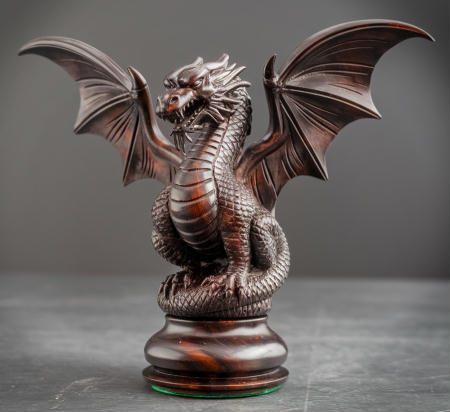The Piececlopedia: Dragon
Historic remarks

The exact origins of this piece are unknown (if you have more information, please let us know). The earliest reference I have to it is in T.R. Dawson's Five Classics of Fairy Chess in which there is a dragon problem originally published in 1913. Although it has some popularity as a problem piece, I know of no games that use it.
Movement rules
The dragon has the combined powers of the normal chess knight, and the normal chess pawn. The dragon can capture en passant, but does not promote upon reaching the eighth rank. A dragon on the second rank which has not yet moved can make the intial double-step, and therefore can also be captured en passant (in problems, if a dragon is on the second rank in the problem's starting position, then it is considered to have not yet moved, unless retro-grade analysis can prove otherwise).
Movement diagram
In the diagram below, the dragon, which is traditionally symbolized as a sideways knight, can do any of the following: - move, but not capture, to a square marked with a green circle. - capture, but not move without capturing, to a square marked with a red circle. - move or capture, regardless of intervening pieces, to a square marked with a black circle.
![]()
![]()
![]()
![]()
![]()
![]()
![]()
![]()
![]()
![]()
![]()
![]()
![]()
![]()
![]()
![]()
![]()
![]()
![]()
![]()
![]()
![]()
![]()
![]()
![]()
![]()
![]()
![]()
![]()
![]()
![]()
![]()
![]()
![]()
![]()
![]()
![]()
![]()
![]()
![]()
![]()
![]()
![]()
![]()
![]()
![]()
![]()
![]()
![]()
![]()
![]()
![]()
![]()
![]()
![]()
![]()
![]()
![]()
![]()
![]()
![]()
![]()
![]()
![]()
Dragon Mating Problem
In the problem below, White mates in 3. This problem is taken from part 5 of T.R Dawson's masterpiece Five Classics of Fairy Chess.
![]()
![]()
![]()
![]()
![]()
![]()
![]()
![]()
![]()
![]()
![]()
![]()
![]()
![]()
![]()
![]()
![]()
![]()
![]()
![]()
![]()
![]()
![]()
![]()
![]()
![]()
![]()
![]()
![]()
![]()
![]()
![]()
![]()
![]()
![]()
![]()
![]()
![]()
![]()
![]()
![]()
![]()
![]()
![]()
![]()
![]()
![]()
![]()
![]()
![]()
![]()
![]()
![]()
![]()
![]()
![]()
![]()
![]()
![]()
![]()
![]()
![]()
![]()
![]()
Written by Benjamin C Good. AI image added by Fergus Duniho.
WWW page created: January 15, 1999.
Last updated: April 07, 2025.
